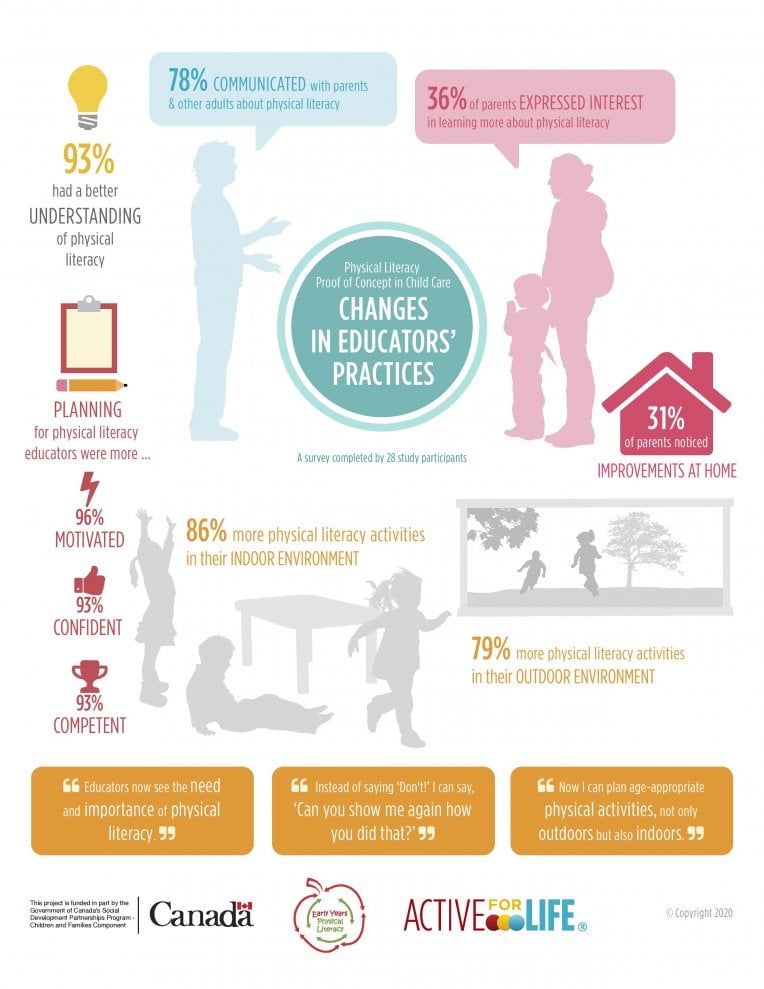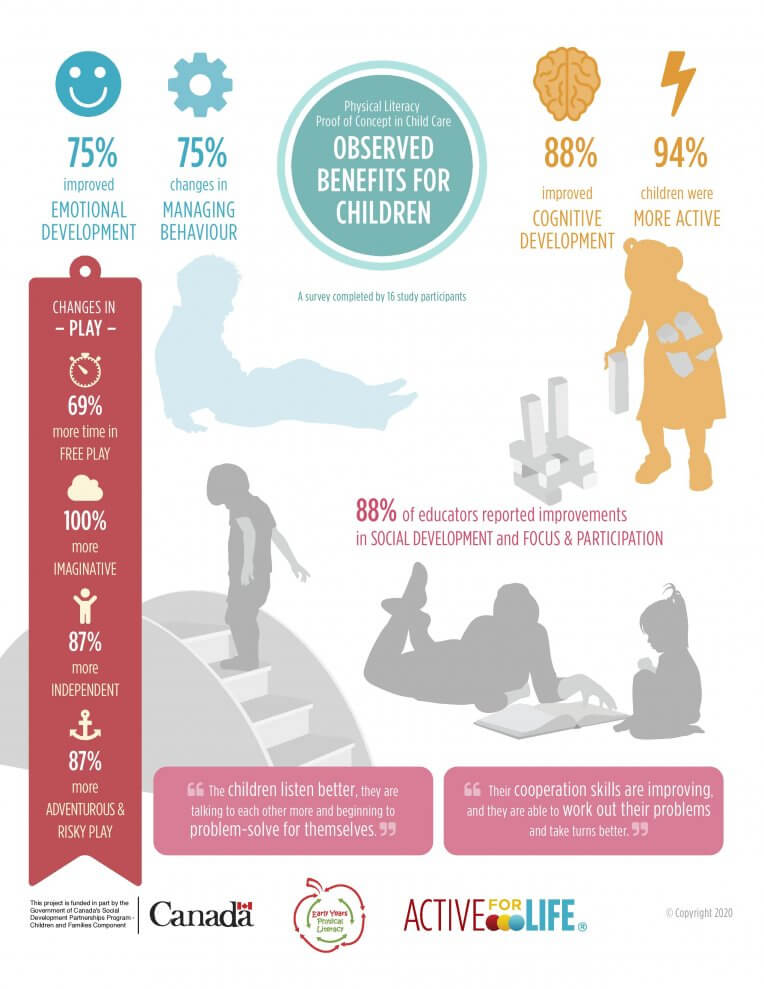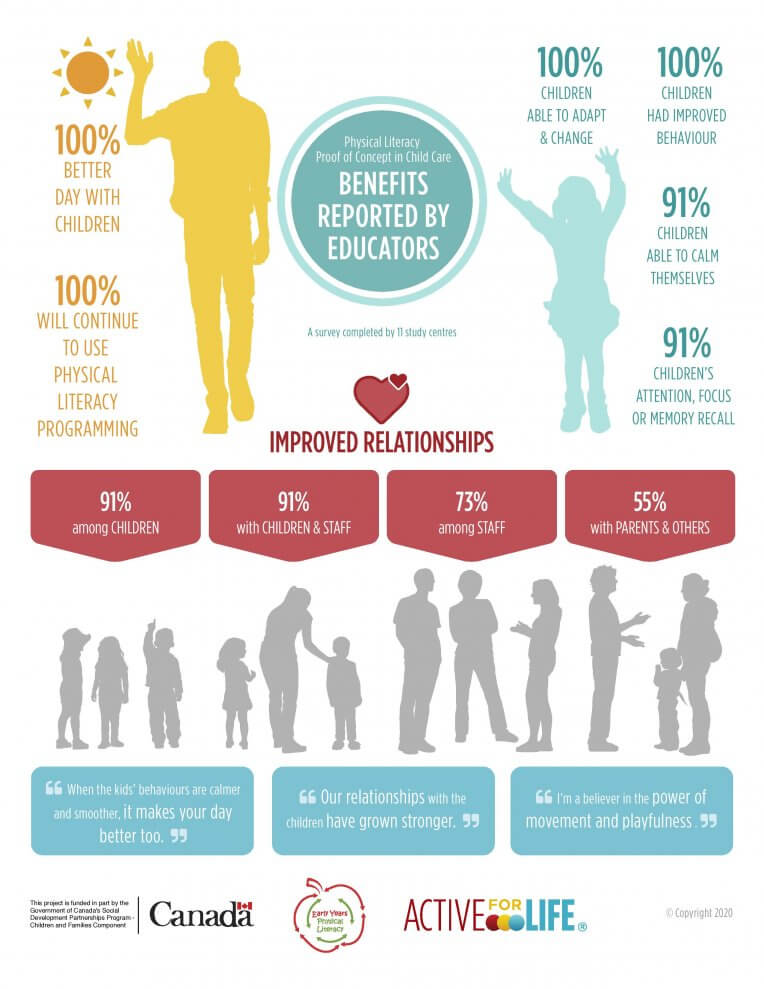
How physical literacy in childcare benefits children, parents and ECEs
Activities to improve babies’ and young children’s physical literacy are easy to plan, simple to do, and require no special equipment. And, according to a two-year Canadian study in early child care centres, the benefits of adding more physically active play time into daily routines are more than just physical.
Watch the video below to learn how active play in child care benefits children and educators:
The Physical Literacy Proof of Concept Study in Child Care Settings measured the impacts of adding physical literacy programming for babies, toddlers, and preschoolers in 39 child care centres in Alberta and British Columbia. It found big benefits in all areas of child development (cognitive, social, emotional, and physical), including significant improvements in executive function, language and communication skills, and emotional self-regulation.
But that’s not all: early childhood educators also reported that including more physically active play, every day, made their work easier, more effective—and more fun!
Benefits of physical literacy programming
Over the two years of the study, 23 centres were provided with guidance on how to incorporate physical literacy programming in the form of physically active play to their daily schedule, while 16 control centres were given no special intervention. Almost 100 early childhood educators and over 600 children were involved in the study, which was funded by Active for Life and the Government of Canada’s Social Development Partnerships Program – Children and Families Component.
This research article was subsequently published in the peer-reviewed International Journal of Social Policy and Education.
According to the researchers, one of the benefits was that the children that received physical literacy programming improved their fundamental movement skills (FMS). More specifically:
- Study group infants showed a strong increase in locomotor skills.
- Study group toddlers showed improvement in manipulative skills and across all FMS.
- Study group preschoolers showed improvement in manipulative skills.
- Across all ages, study group children showed the strongest improvement in manipulative skills and a total overall improvement in all FMS.
And the benefits extended well beyond the children’s physical skills. Educators in study centres who were given lesson plans and information on how to engage children in physically active play and develop physical literacy said:
- Children were better behaved, with fewer challenging behaviours. They got better at problem-solving, adapting to changes in routines, calming themselves in times of distress, and seemed more focused and able to concentrate on their tasks for longer periods.
- Educators spent more time engaging and interacting with children, and felt happier and calmer.
- The bond among children, staff, and families felt stronger.
- Physical literacy programming was easy and inexpensive to incorporate into child care programs, and required little prep time, space, or special equipment.
Notably, 100% of the study group educators surveyed said they intended to continue physical literacy programming after the end of the study.
Free physical literacy programming resources
The free intervention tools, developed by the Early Years Physical Literacy Research Team, applied in the study included:
- APPLE Model – the overall framework for providing active play and physical literacy everyday.
- APPLE Seeds – a 12-week evidence-based program designed to support educators to include physical literacy in their daily programming.
- Hop Skip and Jump – an evidence-based resource manual for parents, caregivers, and professionals.
All resources have been written and piloted extensively by educators over several years and are available for free download.
More study findings on physical literacy benefits for children
The Early Years Physical Literacy Research Team has summarized the key findings of the study in a series of infographics:








We have been promoting Physical Literacy in all of the Child Care Centres in Waterloo County for over a decade now and I would agree with your findings. As a Kinesiologist/Exercise Physiologist, I have been able to assist children who are having issues with their FMS and also have provided education and support for our RECE’s. It is very much worth it to get children on board with Physical Literacy in the early years.
Hey Active for Life Team,
great to see that you’re doing research as well and thank you for the info graphics – well done!
In general, we’re big fans of your organisation and your blogs/articles!
Here in Austria we try to force cooperation between pre-schools/primary schools and sports clubs during regular school day – to get every child active! Furthermore, we executed an Erasmus+ project with 13 organisations from 9 different EU countries. If you’re interested in the outcomes (= Benchmark tool for projects in this sector & scratch video why cooperations in this sector are important) please feel free to check out: www.fitsportaustria.at/main….osoffset=0 or www.youtube.com/watch…1vrmk096Co
Hope to read many more articles from your team :)
All the best for your work – let’s get our kids active!
Greetings from Vienna,
Team of Fit Sport Austria